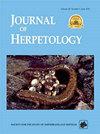从热带Agamid的空间利用模式推断其一生中的社会互动
IF 0.8
4区 生物学
Q3 ZOOLOGY
引用次数: 3
摘要
摘要建立一个群体的社会系统是研究行为进化的关键。然而,对许多物种来说,很难获得推断社会系统所需的社会相互作用的观察结果。另一种理解社会系统的方法是研究个人的空间使用模式。与生态因素一起,空间的使用在很大程度上是由个体之间的相互作用决定的:通常,竞争的个体相互回避,相互受益的个体共享空间。本文通过量化热带背沙蜥个体在其成年期的空间利用模式,研究了其社会系统,特别是交配系统,以及成虫之间无性互动的本质。在交配季节,雄性的活动范围比雌性大得多,但在非交配季节则不然。雌性的家庭范围很小,并且在整个生命周期中与其他雌性的重叠很少,这表明雌性之间存在一致的性内竞争。相比之下,雄性在非交配季节与其他雄性的重叠很少,但在交配季节重叠增加,这表明雄性在交配季节通过其他方式解决性内竞争,如竞争。在交配季节,雄性和雌性家庭范围之间的重叠模式表明了一种社会一夫多妻制的交配制度。我们的研究初步了解了一种热带蜥蜴——背沙蜥(Psammophilus dorsalis)在整个生命周期内的性内和性间互动的范围模式和相关推论。它强调了从个体的分散模式中获得的对种群社会结构的见解。本文章由计算机程序翻译,如有差异,请以英文原文为准。
Inferring Social Interactions Over a Lifespan from Space-Use Patterns in a Tropical Agamid
Abstract. Establishing the social system of a population is key to studying the evolution of behaviors. However, observations of social interactions needed to infer social systems are difficult to obtain for many species. An alternative way of understanding social systems is by studying the space-use pattern of individuals. Along with ecological factors, space use is largely governed by interactions among individuals: typically, competing individuals avoid each other, and individuals benefitting from each other share space. We investigated the social system, specifically the mating system, and the nature of intrasexual interactions between adults, by quantifying space-use patterns of individuals over their adult lifespan in the tropical Psammophilus dorsalis lizard. Males had substantially larger home ranges than females during the mating season, but not during the nonmating season. Female home ranges were small, and showed minimal overlap with other females throughout their lifespan, suggesting consistent intrasexual competition among females. In contrast, males showed minimal overlap with other males in the nonmating season but increased overlap in the mating season, suggesting that males resolve intrasexual competition through other means, like contests, during the mating season. Patterns of overlap between male and female home ranges in the mating season indicated a socially polygynous mating system. Our study provides an initial understanding of home-range patterns and associated inferences of within- and between-sex interactions across the lifespan of a tropical lizard, Psammophilus dorsalis. It highlights the insights into the social structure of a population gained from dispersion patterns of individuals.
求助全文
通过发布文献求助,成功后即可免费获取论文全文。
去求助
来源期刊

Journal of Herpetology
生物-动物学
CiteScore
1.60
自引率
0.00%
发文量
45
审稿时长
6 months
期刊介绍:
The Journal of Herpetology accepts manuscripts on all aspects on the biology of amphibians and reptiles including their behavior, conservation, ecology, morphology, physiology, and systematics, as well as herpetological education. We encourage authors to submit manuscripts that are data-driven and rigorous tests of hypotheses, or provide thorough descriptions of novel taxa (living or fossil). Topics may address theoretical issues in a thoughtful, quantitative way. Reviews and policy papers that provide new insight on the herpetological sciences are also welcome, but they must be more than simple literature reviews. These papers must have a central focus that propose a new argument for understanding a concept or a new approach for answering a question or solving a problem. Focus sections that combine papers on related topics are normally determined by the Editors. Publication in the Long-Term Perspectives section is by invitation only. Papers on captive breeding, new techniques or sampling methods, anecdotal or isolated natural history observations, geographic range extensions, and essays should be submitted to our sister journal, Herpetological Review.
 求助内容:
求助内容: 应助结果提醒方式:
应助结果提醒方式:


